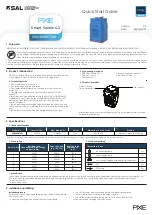
1-8
feedbacks (through a RADIUS access-accept packet and an EAP-success packet) to the switch to
indicate that the supplicant system is authenticated.
z
The switch changes the state of the corresponding port to accepted state to allow the supplicant
system to access the network.
z
The supplicant system can also terminate the authenticated state by sending EAPoL-Logoff
packets to the switch. The switch then changes the port state from accepted to rejected.
In EAP relay mode, packets are not modified during transmission. Therefore if one of the four ways are
used (that is, PEAP, EAP-TLS, EAP-TTLS or EAP-MD5) to authenticate, ensure that the authenticating
ways used on the supplicant system and the RADIUS server are the same. However for the switch, you
can simply enable the EAP relay mode by using the
dot1x
authentication-method eap
command.
EAP terminating mode
In this mode, EAP packet transmission is terminated at authenticator systems and the EAP packets are
converted to RADIUS packets. Authentication and accounting are carried out through RADIUS
protocol.
In this mode, PAP or CHAP is employed between the switch and the RADIUS server.
Figure 1-9
illustrates the authentication procedure (assuming that CHAP is employed between the switch and the
RADIUS server).
Содержание Switch 4500 Family
Страница 89: ...1 6 round trip min avg max 2 3 5 ms...
Страница 257: ...ii Configuring IGMP Snooping 1 17 Configuring Multicast VLAN 1 18 Troubleshooting IGMP Snooping 1 21...
Страница 294: ...1 22 z If the multicast group set up by IGMP Snooping is not correct contact your technical support personnel...
Страница 361: ...3 27 Sysname isp system radius scheme cams...
Страница 726: ...1 18 0 00 packet loss round trip min avg max 50 60 70 ms...
Страница 739: ...i Table of Contents Appendix A Acronyms A 1...
















































